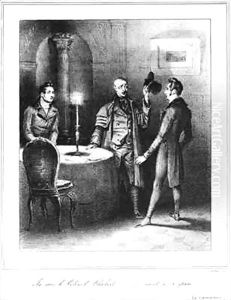Louis Philippe Alphonse Bichebois Paintings
Louis Philippe Alphonse Bichebois was a French lithographer born in 1801, known for his architectural and landscape lithographs. He played a significant role in the early 19th century, a period that saw the rise of lithography as a popular form of printmaking. Bichebois specialized in producing detailed prints of architectural wonders, both existing and idealized, as well as picturesque landscapes, contributing to the era's fascination with romantic and neoclassical themes.
During his career, Bichebois collaborated with many prominent artists and architects of his time, translating their works into lithographs that were widely circulated. His ability to capture intricate details and his sensitivity to the nuances of light and shadow made his prints highly valued for both their artistic merit and their documentary value. Bichebois's works served not only as beautiful pieces of art but also as valuable records of architectural history, providing insights into the designs and aesthetics of the early 19th century.
Despite his contributions to the art of lithography and the preservation of historical architecture through his prints, Bichebois has not remained as well-known as some of his contemporaries. However, his lithographs continue to be appreciated by collectors and historians for their beauty and historical significance. Louis Philippe Alphonse Bichebois passed away in 1850, leaving behind a legacy of work that remains a testament to the lithographic arts and the architectural visions of his time.
